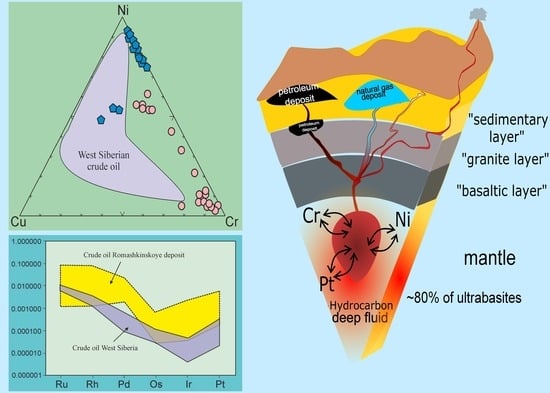Inorganic Geochemistry of Crude Oils of Northern Eurasia after ICP-MS Data as Clear Evidence for Their Deep Origin
Abstract
:1. Introduction
2. Materials and Methods
3. Results and Discussion
3.1. Inorganic Geochemistry of West-Siberian Oil and Gas Megabasin
3.1.1. Shaimsky District
3.1.2. Sredneobsky District
3.1.3. Oktyabrsky District
3.2. Inorganic Geochemistry of Tatarstan Crude Oils
4. Conclusions
Author Contributions
Funding
Acknowledgments
Conflicts of Interest
References
- Alekseev, V.P.; Fedorov, Y.N.; Gazaleev, S.S.; Russian, V.I.; Svechnikov, L.I.; Khakimov, A.F. History of the Formation of Deposits of the Tyumen Suite of the Shaim Oil and Gas Region Geologiya Ugol’nykh Depositov-Geology of Coal Deposits; Publishing House of USMU: Yekaterinburg, Russia, 2004; pp. 130–139. [Google Scholar]
- Vinokurov, S.F.; Gottikh, R.P.; Pisotsky, B.I. Complex analysis of the distribution of lanthanides in aphaltenes, waters and rocks to clarify the conditions for the formation of oil fields. Dokl. Akad. Nauk. Rep. Acad. Sci. 2000, 370, 83–86. [Google Scholar]
- Voitkevich, G.V.; Miroshnikov, A.E.; Povarenykh, A.S.; Prokhorov, V.G. A Short Guide to Geochemistry; Nedra: Moscow, Russia, 1970; 280p. [Google Scholar]
- Ivanov, K.S.; Kormiltsev, V.V.; Fedorov, Y.N. The main features of the structure of the pre-Jurassic basement of the Shaim oil and gas region—Ways of Realization of Oil and Gas Potential of Khanty-Mansi Autonomous Okrug. In Proceedings of the Scientific and Practical Conference, Khanty-Mansiysk, Russia, 19 December 2003; Volume 1, pp. 102–113. [Google Scholar]
- Ivanov, K.S.; Erokhin, Y.V.; Ronkin, Y.L.; Plotnikova, I.N.; Kayukova, G.P. Inorganic geochemistry of oil from the Romashkinskoye field—The first results of research using the ICP-MS method. In Hydrocarbon Potential of the Basement of Young and Ancient Platforms; KazGU Publishing House: Kazan, Russia, 2006; pp. 100–103. [Google Scholar]
- Marakushev, A.A.; Pisotsky, B.I.; Paneyakh, N.A.; Gottikh, R.P. Geochemical specificity of oil and the origin of its deposits. Dokl. Akad. Nauk. Rep. Acad. Sci. 2004, 398, 795–799. [Google Scholar]
- Nadirov, N.K.; Kotova, A.V.; Kamyanov, V.F. New oils of Kazakhstan and their use: Metals in oils. Alma Ata Sci. 1984, 1, 448. (In Russian) [Google Scholar]
- Adbulmazitov, R.G.; Ananiev, V.V.; Voitovich, E.D.; Gatiyatullin, N.S.; Mironova, L.M.; Muslimov, R.K.; Plotnikova, I.N.; Smelkov, V.M.; Tukhvatullin, R.K.; Uspensky, B.V.; et al. Oil and Gas Potential of the Republic of Tatarstan. Geology and Development of Oil Fields; Muslimov, R.K., Ed.; Publishing House “Feng” of the Academy of Sciences of the Republic of Tatarstan: Kazan, Russia, 2007; Volume 1. (In Russian) [Google Scholar]
- Pecherkin, M.; Veremko, H.A.; Guzeev, B.B.; Kumin, Y.A. Features of the Geological Structure and Development of Deposits in the Shaim Oil and Gas Region; Lukoil: Moscow, Russia, 2002; 283p. (In Russian) [Google Scholar]
- Plotnikova, I.N. Geological-Geophysical and Geochemical Preconditions for the Oil and Gas Potential of the Crystalline Basement of Tatarstan; Nedra: Saint Petersburg, Russia, 2004; 146p. [Google Scholar]
- Fedorov, Y.N.; Alekseev, V.P.; Ivanov, K.S.; Pecherkin, M.F.; Svechnikov, L.I. New geological data and prospects for the growth of active oil reserves in the Shaim region. Oil Ind. 2004, 6, 22–25. [Google Scholar]
- Fedorov, Y.N.; Ivanov, K.S.; Erokhin, Y.V.; Ronkin, Y.L. Inorganic oil geochemistry of the Shaim region (West Siberian oil and gas megabasin). Collective Ways of Realization Oil Gas Potential Khanty-Mansi Autonomous Okrug-Yugra. In Proceedings of the Ninth Scientific and Practical Conference, Khanty-Mansiysk, Russia, 7–9 June 2006; Volume 1, pp. 306–314. [Google Scholar]
- Fedorov, Y.N.; Ivanov, K.S.; Erokhin, Y.V.; Ronkin, Y.L. Inorganic geochemistry of oil in Western Siberia (the first results of the study by the ICP-MS method). Dokl. Akad. Nauk. Rep. Acad. Sci. 2007, 414, 385–388. [Google Scholar]
- Fish, R.M.; Komlenic, J.J. Molecular characterization and profile identification of vanadil compounds in heavy crude petroleum’s by liquid chromatography/graphite furnace atomic absorption spectrometry. Anal. Chem. 1984, 56, 2452–2460. [Google Scholar] [CrossRef]
- Naldrett, A.J.; Duke, J.M. Platinum metals in magmatic sulfide ores. Science 1980, 208, 1417–1424. [Google Scholar] [CrossRef]
- Nakamura, N. Determination of REE, Ba, Fe, Mg, Na and K in carbonaceous and ordinary chondrities. Geochim. Cosmochim. Acta 1974, 38, 757–775. [Google Scholar] [CrossRef]
- Marakushev, A.A.; Pisotskii, B.I.; Paneyakh, N.A.; Gottikh, R.P. Geochemical features of oil and the origin of oil fields. Dokl. Earth Sci. 2004, 399, 1120–1124. [Google Scholar]
- Ivanov, K.S.; Kucherov, V.G.; Fedorov, Y.N. On the Question of the Deep Origin of Oil STATE, Trends and Problems of Development of Oil and Gas Potential of Western Siberia. Materials of the International Academic Conference; ZapSibNIIGG: Tyumen, Russia, 2008; pp. 160–173. [Google Scholar]
- Gottikh, R.P.; Vinokurov, S.F.; Pisotskii, B.I. Rare-earth elements as geochemical criteria of endogenous sources of microelements contained in oil. Dokl. Earth Sci. 2009, 425, 325–329. [Google Scholar] [CrossRef]
- Punanova, S.A. Trace elements in naphthides and their application to the development of oil and gas condensate fields. Neftekhimiya 2001, 41, 165–193. [Google Scholar]
- Rodkin, M.V.; Rundkvist, D.V.; Punanova, S.A. The relative role of lower and upper crustal processes in the formation of trace element compositions of oils. Geochem. Int. 2016, 54, 989–995. [Google Scholar] [CrossRef]
- Pearcon, C.D.; Green, J.B. Comparison of processing characteristics of Magan and Wilmington heavy residues. Characterization of vanadium and nickel complexes in acid-base-neutral fractions. Fuel 1989, 68, 465–468. [Google Scholar] [CrossRef]
- Hackford, J.E. The significance of the interpretation of the chemical analyses of seepages. J. Inst. Petrol. Tech. 1922, 8, 193–213. [Google Scholar]
- Guthrie, W.A. Heavy grade Egyptian crude oil. J. Inst. Petrol. Tech. 1923, 9, 212–248. [Google Scholar]
- Ramsay, W. The significance of nickel in petroleum. J. Inst. Petrol. Tech. 1924, 10, 87–91. [Google Scholar]
- De Golyer, E. The occurrence of vanadium and nickel in petroleum. Econ. Geol. 1924, 19, 550–558. [Google Scholar]
- Bakirova, S.F.; Kotova, A.V.; Yagyayeva, S.; Fedorova, N.; Nadirov, N.K. Structural features of vanadyl porphyrins of petroleum of West Kazakhstan. Pet. Chem. USSR 1984, 24, 196–202. [Google Scholar] [CrossRef]
- Chai, C.; Ding, Z.; Fu, J.; Sheng, G. Determination of trace elements in crude oils and organic materials extracted from oil-forming source rocks in China by INAA. J. Radio Anal. Nucl. Chem. 2005, 151, 177–184. [Google Scholar]
- Tadayon, F.; Massoumi, A.; Eslami, M. Determination of vanadium, nickel, and iron in crude oil by High-Performance Liquid Chromatography. J. Chromatogr. Sci. 1999, 37, 371–374. [Google Scholar] [CrossRef] [Green Version]
- Sebor, G.; Lang, I.; Vavrecka, P.; Sychra, V.; Weisser, O. The determination o metals in petroleum samples by Atomic Absorption Spectrometry, part I. The determination of Vanadium. Anal. Chim. Acta 1975, 78, 99–106. [Google Scholar] [CrossRef]
- Botto, R.I. Matrix interferences in the analysis of organic solutions by Inductively Coupled Plasma-Atomic Emission Spectrometry. Spectrochim. Acta Part B 1987, 42, 181–199. [Google Scholar] [CrossRef]
- Saint’Pierre, T.; Dias, L.F.; Pozebon, D.; Aucelio, R.Q.; Curtius, A.J.; Welz, B. Determination of Cu, Mn, Ni and Sn in gasoline by Electrothermal Vaporization Inductively Coupled Plasma Mass Spectrometry, and Emulsion Sample Introduction. Spectrochim. Acta Part B 2002, 57, 1991–2001. [Google Scholar] [CrossRef]
- Mattinson, J.M. Preparation of hydrofluoric, hydrochloric, and nitric acids at ultralow lead levels. Anal. Chem. 1972, 44, 1715–1716. [Google Scholar] [CrossRef]
- Gießmann, U.; Greb, U. High-resolution ICP-MS—A new concept for elemental mass spectrometry. Fresenius J. Anal. Chem. 1994, 350, 186–193. [Google Scholar] [CrossRef]
- Taylor, S.R.; McLennan, S.M. The Continental Crust: Its Composition and Evolution; Blackwell: Oxford, UK, 1985; 312p. [Google Scholar]
- Botto, R.I. Applications of ultrasonic nebulization in the analysis of petroleum and petrochemicals by Inductively Coupled Plasma atomic emission spectrometry. J. Anal. Atom. Spectrom. 1993, 8, 51–57. [Google Scholar] [CrossRef]
- Botto, R.I. Trace element analysis of petroleum naphtas and tars using direct injection ICP-MS. Can. J. Anal. Sci. Spect. 2002, 47, 1–13. [Google Scholar]
- Dreyfus, S.; Pecheyran, C.; Magnier, C.; Prinzhofer, A.; Lienemann, C.P.; Donard, O.F.X. Direct trace and ultra-trace metals determination in crude oil and fractions by inductively coupled plasma mass spectrometry. J. ASTM Int. 2005, 2, 1–8. [Google Scholar] [CrossRef]
- Duyck, C.; Miekeley, N.; Porto da Silveira, C.L.; Szatmari, P. Trace element determination in crude oil and its fractions by Inductively Coupled Plasma Mass Spectrometry using ultrasonic nebulization of toluene solutions. Spectrochim. Acta B 2002, 57, 1979–1990. [Google Scholar] [CrossRef]
- Lienemann, C.P.; Dreyfus, S.; Pecheyran, C.; Donard, O.F.X. Trace metal analysis in petroleum products: Sample introduction evaluation in ICP-OES and comparison with an ICP-MS approach. Oil Gas Sci. Technol. 2007, 62, 69–77. [Google Scholar] [CrossRef]
- Poirier, L.; Nelson, J.; Leong, D.; Berhane, L.; Hajdu, P.; Lopez-Linares, F. Application of ICP-MS and ICP-OES on the determination of nickel, vanadium, iron, and calcium in petroleum crude oils via direct dilution. Energy Fuels 2016, 30, 3783–3790. [Google Scholar] [CrossRef]
- Agyingi, C.M.; Abanda, P.A.; Fozao, K.F.; Njoh, O.A.; Epanty, A.F.; Tangko, N.C.; Kwangkam, F.N.; Eseme, E. Geochemistry of seep and produced oil samples from Southern Cameroon. J. Pet. Geol. 2019, 42, 193–206. [Google Scholar] [CrossRef]
- Al-Swaidan, H.M. The determination of lead, nickel and vanadium in Saudi Arabian crude oil by sequential injection analysis/Inductively-Coupled Plasma Mass Spectrometry. Talanta 1996, 43, 1313–1319. [Google Scholar] [CrossRef]
- Lopez, L.; Mynaco, S.L. Geochemical implications of trace elements and sulfur in the saturate, aromatic and resin fractions of crude oil from the Mara and Mara Oeste fields, Venezuela. Fuel 2004, 83, 365–374. [Google Scholar] [CrossRef]
- Rabbani, A.R. Geochemistry of crude oil samples from the Iranian sector of the Persian Gulf. J. Pet. Geol. 2008, 31, 303–316. [Google Scholar] [CrossRef]
- Baturin, G.N. Phosphogenesis hypotheses and oceanic environment. Lithol. Useful Miner. 1999, 5, 451–472. [Google Scholar]
- Baturin, G.N. Europium anomaly in oceanic phosphorites. Geochemistry 2001, 379, 647–650. [Google Scholar]
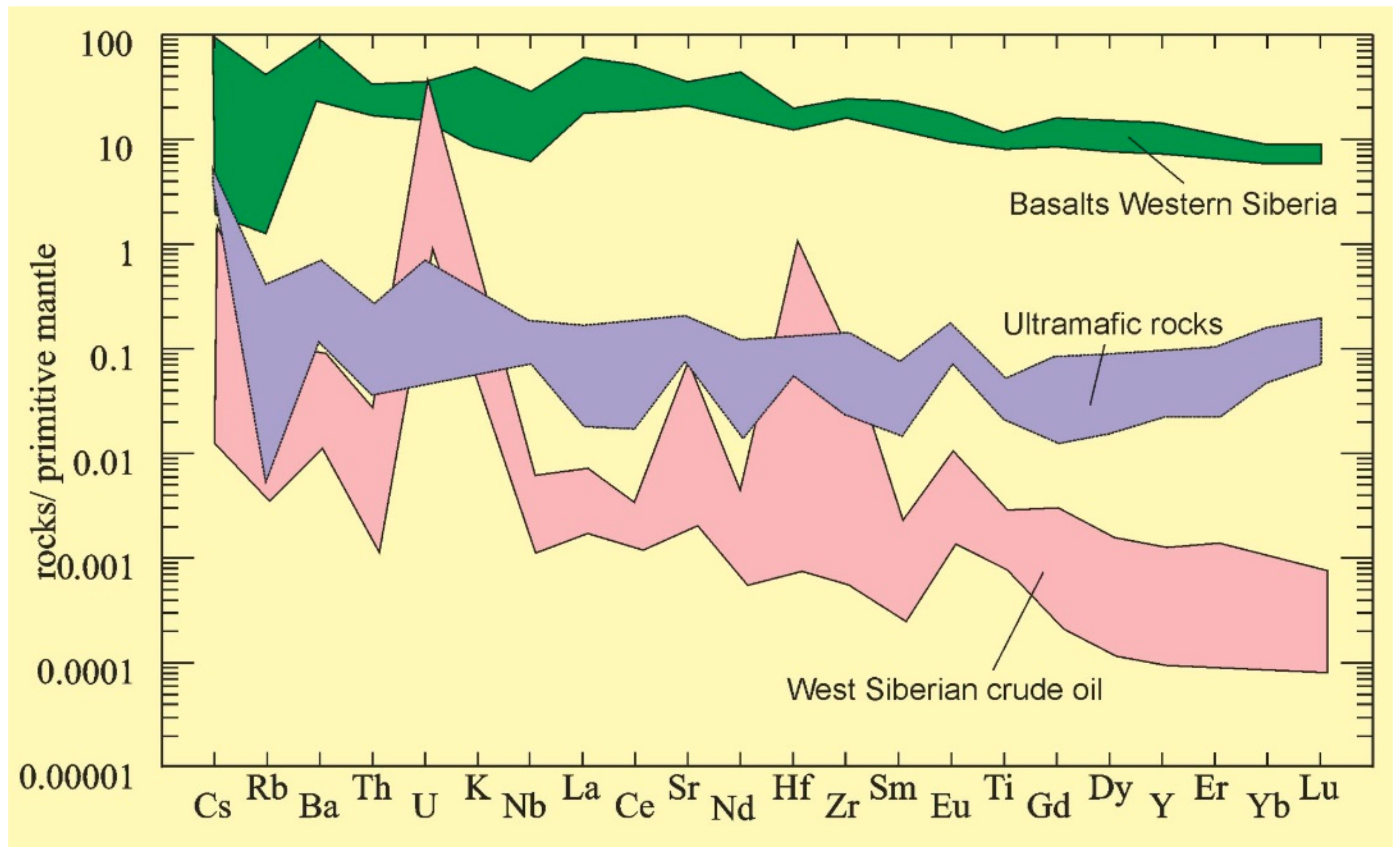
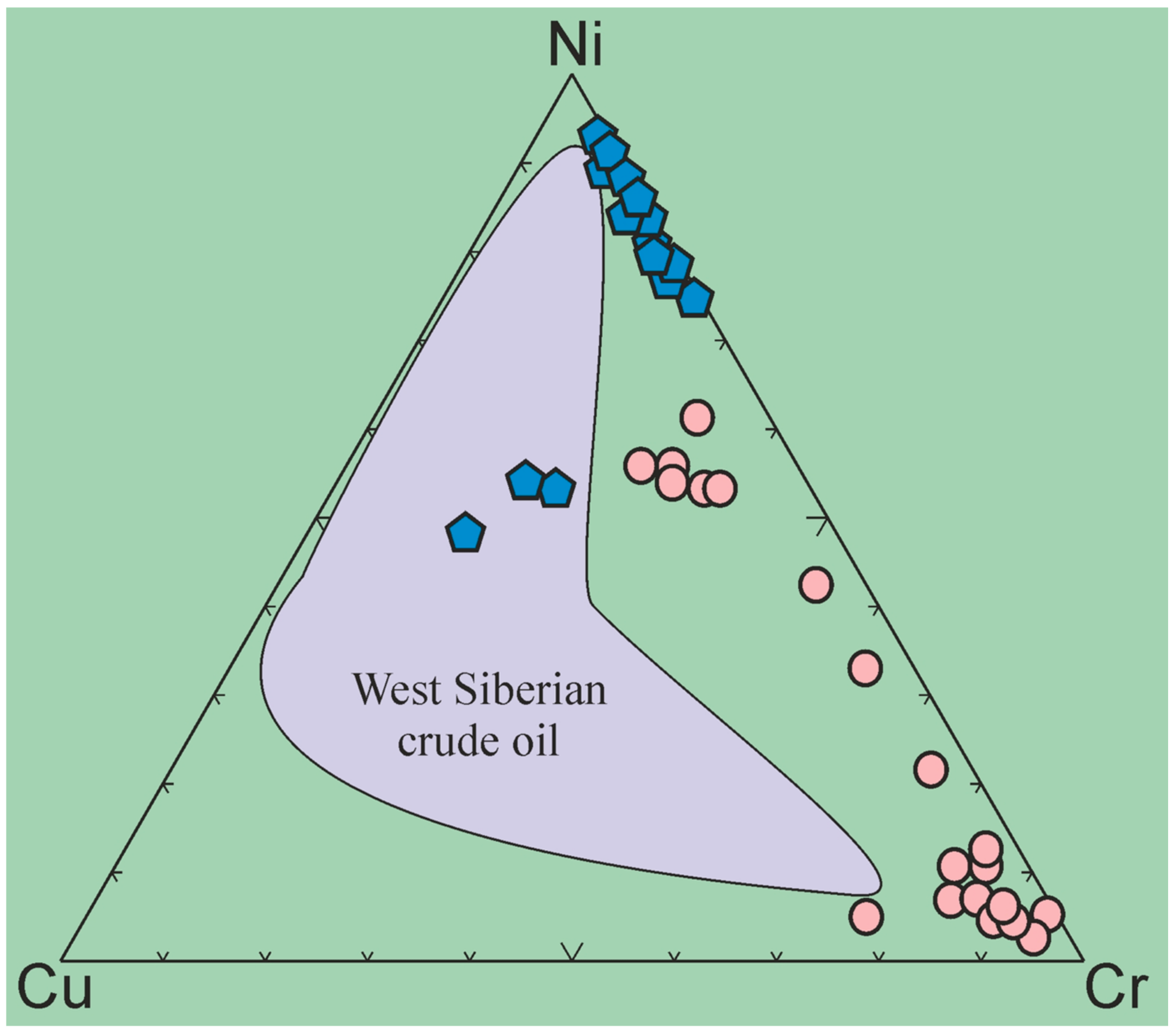
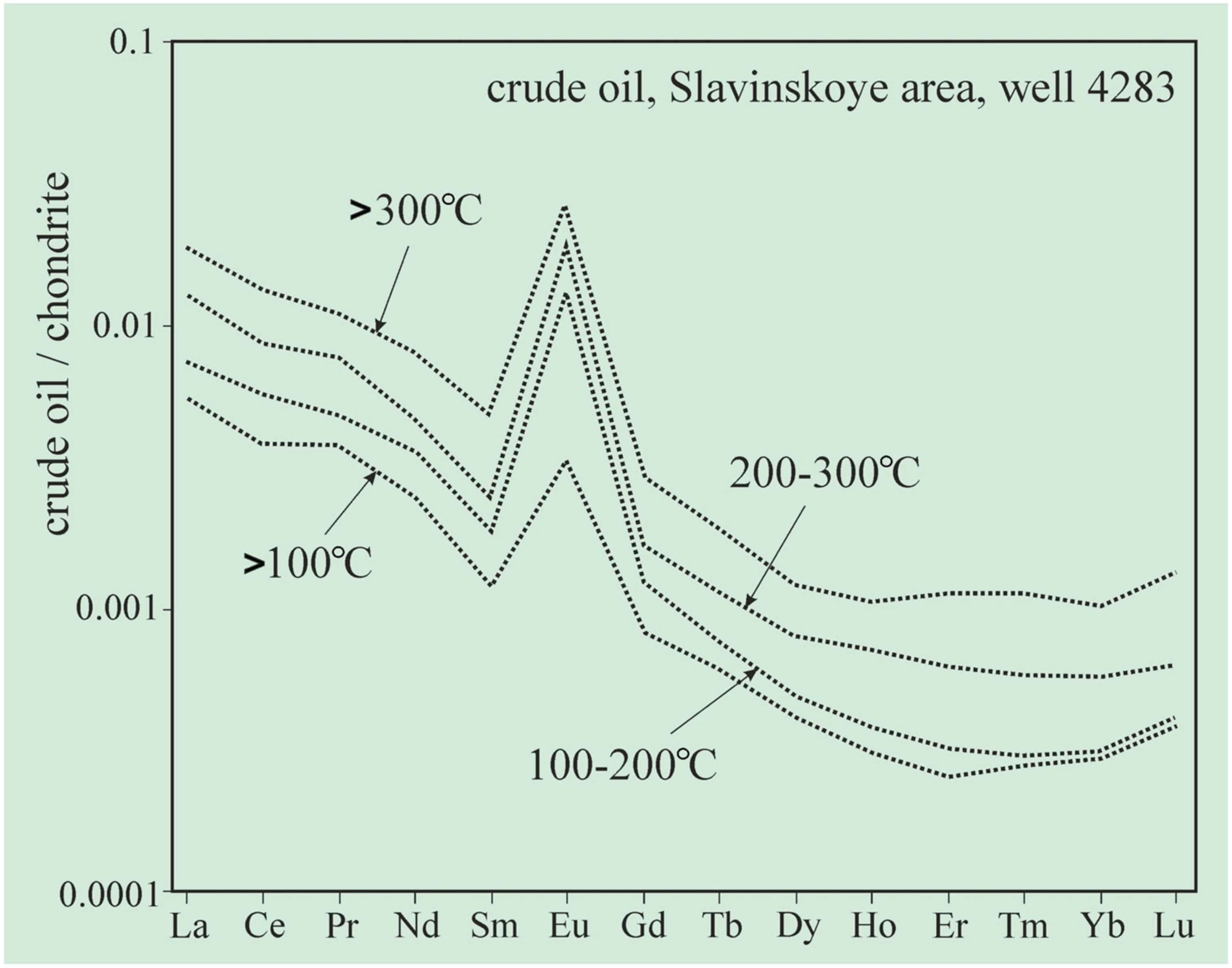

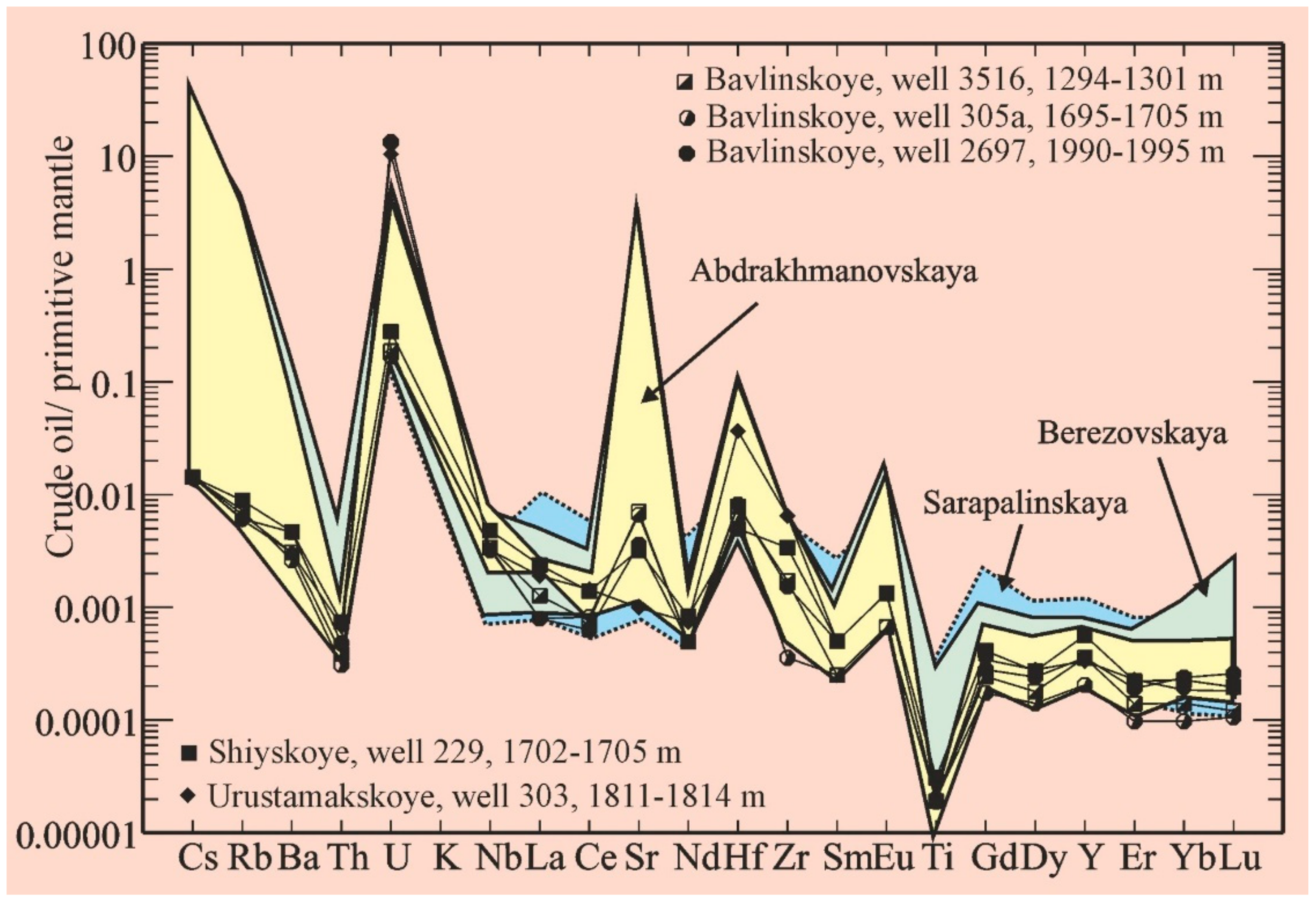
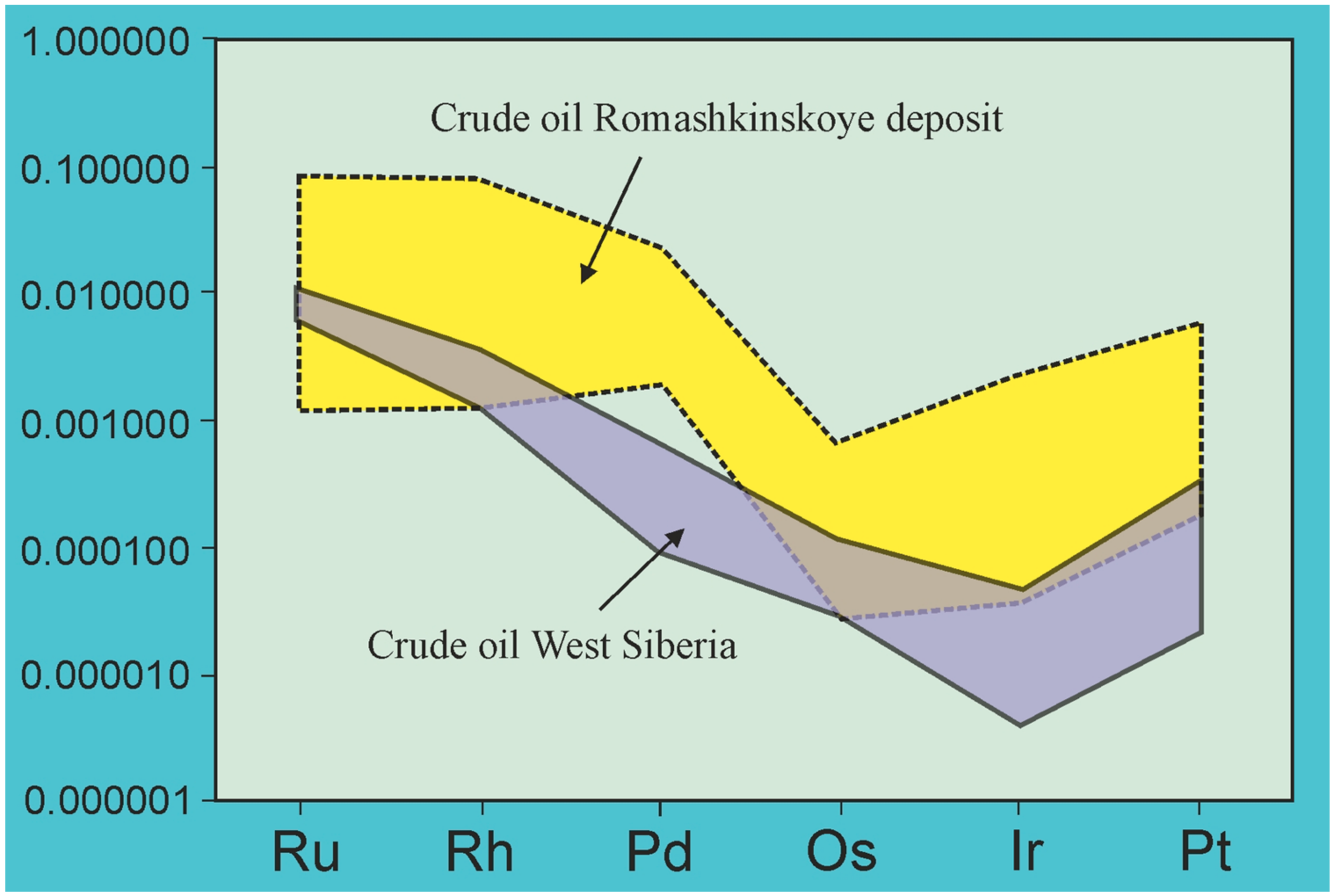
| Elements | 1 | 2 | 3 | 4 | 5 | 6 | 7 | 8 |
|---|---|---|---|---|---|---|---|---|
| Li | - | - | - | 0.00268 | 0.00550 | 0.00448 | 0.00753 | 0.00089 |
| Be | 0.00037 | 0.00386 | 0.00311 | 0.00068 | 0.00090 | 0.00080 | 0.00036 | 0.00036 |
| B | 0.00058 | 0.00073 | 0.00066 | 0.05321 | 0.13300 | 0.06020 | 0.06500 | 0.04371 |
| Mg | 0.72588 | 13.85470 | 12.40090 | 0.47086 | 0.91731 | 0.56882 | 0.39074 | 0.71989 |
| Al | 0.15236 | 9.52140 | 8.27537 | 1.12454 | 1.37350 | 1.01343 | 1.09291 | 1.84287 |
| Sc | 0.00296 | 0.15687 | 0.13227 | 0.11998 | 0.11444 | 0.10873 | 0.17218 | 0.14430 |
| Ti | 0.01347 | 0.97335 | 0.87796 | 2.89765 | 2.74938 | 2.35654 | 3.56146 | 1.78890 |
| V | 3.35400 | 0.17643 | 1.31451 | 10.4498 | 11.6318 | 8.86100 | 9.33210 | 6.48840 |
| Cr | 14.54280 | 5.29674 | 10.81830 | 28.49950 | 32.74460 | 28.67820 | 17.22580 | 25.54590 |
| Mn | 0.02083 | 0.15319 | 0.12857 | 0.11641 | 0.59776 | 0.11036 | 0.16766 | 0.63659 |
| Fe | 5.03300 | 49.0878 | 43.73300 | 52.17240 | 48.92040 | 35.91540 | 38.31820 | 35.9450 |
| Co | 0.00153 | 0.00851 | 0.00473 | 0.01246 | 0.00702 | 0.07782 | 0.09166 | 0.00702 |
| Ni | 0.91805 | 0.41504 | 1.03197 | 10.11420 | 4.57676 | 17.0646 | 14.7218 | 3.12589 |
| Cu | 0.00146 | 1.36885 | 1.35712 | 1.77310 | 2.06376 | 1.67553 | 1.83192 | 1.93616 |
| Zn | 0.18462 | 1.36437 | 1.48157 | 4.98010 | 5.84579 | 6.30084 | 4.85887 | 11.7174 |
| Ga | 0.05859 | 0.00541 | 0.00827 | 0.15353 | 0.15572 | 0.13375 | 0.04740 | 0.12771 |
| As | 0.52042 | 0.17214 | 0.09681 | 0.6819 | 0.83962 | 0.78702 | 0.58810 | 0.66959 |
| Rb | 0.02364 | 0.05573 | 0.02794 | 0.00194 | 0.00696 | 0.00255 | 0.01205 | 0.01118 |
| Sr | 0.05428 | 0.09392 | 0.47156 | 0.21142 | 0.65098 | 0.46156 | 0.58319 | 1.69799 |
| Y | 0.00089 | 0.00107 | 0.00039 | 0.00041 | 0.00104 | 0.00069 | 0.00087 | 0.00079 |
| Zr | 0.00658 | 0.85219 | 0.44027 | 0.12356 | 0.20415 | 0.10810 | 0.10668 | 0.12442 |
| Nb | 0.00078 | 0.00159 | 0.00122 | 0.00210 | 0.00408 | 0.00313 | 0.00203 | 0.00338 |
| Mo | 0.16910 | 0.13347 | 0.11708 | 0.09874 | 0.05995 | 0.05183 | 0.05682 | 0.05256 |
| Ru | 0.00080 | 0.00717 | 0.00568 | 0.00329 | 0.00580 | 0.00226 | 0.00411 | 0.00509 |
| Rh | 0.00122 | 0.00024 | 0.00022 | 0.00027 | 0.00016 | 0.00009 | 0.00051 | 0.00033 |
| Pd | 0.00216 | 0.03744 | 0.01931 | 0.01056 | 0.01635 | 0.00820 | 0.00952 | 0.01052 |
| Ag | 0.01075 | 0.00098 | 0.00421 | 0.00416 | 0.00296 | 0.00339 | 0.00321 | 0.00506 |
| Cd | 0.00204 | 0.00450 | 0.00048 | 0.01396 | 0.00720 | 0.00891 | 0.00821 | 0.00967 |
| In | 0.00034 | 0.00139 | 0.00216 | 0.00005 | 0.00043 | 0.00062 | 0.00044 | 0.00051 |
| Sn | 0.16198 | 0.00108 | 0.38763 | 0.24998 | 0.14538 | 0.14610 | 0.27392 | 0.22622 |
| Sb | 0.00079 | 0.00445 | 0.00285 | 0.00391 | 0.00498 | 0.00354 | 0.00204 | 0.00440 |
| Te | 0.00109 | 0.00223 | 0.00018 | 0.00020 | 0.00033 | 0.00031 | 0.00019 | 0.00028 |
| I | - | - | - | 0.17378 | 1.37407 | 0.27695 | 0.18988 | 0.09614 |
| Cs | 0.00199 | 0.00195 | 0.00194 | 0.00028 | 0.00039 | 0.00042 | 0.00013 | 0.00007 |
| Ba | 0.09914 | 0.19176 | 0.07979 | 0.32165 | 0.28396 | 0.14268 | 0.18009 | 0.53189 |
| La | 0.00129 | 0.00233 | 0.00185 | 0.00237 | 0.00395 | 0.00366 | 0.00548 | 0.00358 |
| Ce | 0.00227 | 0.00402 | 0.00295 | 0.00373 | 0.00552 | 0.00484 | 0.00645 | 0.00456 |
| Pr | 0.00048 | 0.00053 | 0.00043 | 0.00052 | 0.00066 | 0.00048 | 0.00058 | 0.00064 |
| Nd | 0.00194 | 0.00191 | 0.00184 | 0.00145 | 0.00271 | 0.00215 | 0.00181 | 0.00207 |
| Sm | 0.00076 | 0.00059 | 0.00052 | 0.00035 | 0.00028 | 0.00047 | 0.00029 | 0.00029 |
| Eu | 0.00168 | 0.00027 | 0.00029 | 0.00051 | 0.00040 | 0.00005 | 0.00002 | 0.00088 |
| Gd | 0.00155 | 0.00046 | 0.00053 | 0.00049 | 0.00045 | 0.00053 | 0.00048 | 0.00040 |
| Tb | 0.00025 | 0.00009 | 0.00006 | 0.00005 | 0.00005 | 0.00007 | 0.00010 | 0.00006 |
| Dy | 0.00108 | 0.00047 | 0.00048 | 0.00029 | 0.00033 | 0.00039 | 0.00064 | 0.00029 |
| Ho | 0.00023 | 0.00011 | 0.00012 | 0.00006 | 0.00006 | 0.00007 | 0.00013 | 0.00007 |
| Er | 0.00059 | 0.00036 | 0.00033 | 0.00019 | 0.00019 | 0.00022 | 0.00034 | 0.00022 |
| Tm | 0.0001 | 0.00004 | 0.00003 | 0.00002 | 0.00003 | 0.00003 | 0.00005 | 0.00003 |
| Yb | 0.00053 | 0.00012 | 0.00015 | 0.00013 | 0.00019 | 0.00013 | 0.00025 | 0.00017 |
| Lu | 0.00005 | 0.00001 | 0.00002 | 0.00002 | 0.00003 | 0.00002 | 0.00003 | 0.00003 |
| Hf | 0.00458 | 0.33835 | 0.27481 | 0.01208 | 0.01260 | 0.01215 | 0.01418 | 0.01237 |
| Ta | 0.00003 | 0.00165 | - | 0.00019 | 0.00006 | 0.00007 | 0.00002 | 0.00015 |
| W | 0.00256 | 0.01589 | 0.00994 | 0.00870 | 0.00477 | 0.00622 | 0.00406 | 0.00769 |
| Re | 0.00004 | 0.00567 | 0.00004 | 0.00564 | 0.00272 | 0.00400 | 0.00276 | 0.00456 |
| Os | 0.00048 | 0.00017 | 0.00002 | 0.00006 | 0.00005 | 0.00018 | 0.00000 | 0.00000 |
| Ir | 0.00058 | 0.00958 | 0.00622 | 0.0004 | 0.0003 | 0.00016 | 0.00004 | 0.00007 |
| Pt | 0.00162 | 0.01378 | 0.00988 | 0.00094 | 0.00119 | 0.00081 | 0.00027 | 0.00032 |
| Au | 0.00178 | 0.00138 | 0.00084 | 0.00039 | 0.00002 | 0.00049 | 0.00041 | 0.00029 |
| Hg | 0.00245 | 0.02355 | 0.00373 | 0.00185 | 0.00278 | 0.01267 | 0.00549 | 0.00215 |
| Tl | 0.00152 | 0.00125 | 0.00011 | 0.04597 | 0.03323 | 0.04428 | 0.07018 | 0.05134 |
| Pb | 0.00203 | 0.10908 | 0.16143 | 0.14013 | 0.10362 | 0.14296 | 0.23386 | 0.15592 |
| Bi | 0.00118 | 0.00108 | 0.00127 | 0.00080 | 0.00018 | 0.00056 | 0.00145 | 0.00099 |
| Th | 0.00005 | 0.00058 | 0.00028 | 0.00068 | 0.00194 | 0.00068 | 0.00059 | 0.00072 |
| U | 0.03124 | 0.15064 | 0.42804 | 0.34090 | 0.20017 | 0.80753 | 0.43587 | 0.43525 |
| Elements | 1 | 2 | 3 | 4 | 5 | 6 | 7 | 8 |
|---|---|---|---|---|---|---|---|---|
| Li | 0.00400 | 0.00800 | 0.00090 | 0.57000 | 0.38000 | 0.29000 | 0.23000 | 0.34000 |
| Be | 0.00100 | 0.00040 | 0.00040 | 0.00200 | 0.00200 | 0.00300 | 0.00200 | 0.00200 |
| Na | 200.00000 | 3.77000 | 4.37000 | 525.00000 | 970.20000 | 13.1200000 | 87.53000 | 40.35000 |
| Mg | 0.57000 | 0.39000 | 0.71989 | 27.87000 | 17.52000 | 28.52000 | 13.69000 | 12.20000 |
| Al | 1.01000 | 1.09000 | 1.84000 | 36.87000 | 20.81000 | 34.16000 | 30.97000 | 20.07000 |
| P | - | - | - | 2156.00000 | 2001.00000 | 2452.00000 | 1964.00000 | 2173.00000 |
| K | - | - | - | 128.00000 | 95.14000 | 126.00000 | 75.66000 | 92.71000 |
| Ca | - | - | - | 225.00000 | 142.00000 | 220.00000 | 170.00000 | 181.00000 |
| Sc | 0.11000 | 0.17000 | 0.14000r | 1.01000 | 0.28000 | 1.51000 | 0.76000 | 0.81000 |
| Ti | 2.36000 | 3.56000 | 1.79000 | 45.70000 | 14.82000 | 18.94000 | 16.37000 | 19.35000 |
| V | 8.86000 | 9.33000 | 6.49000 | 0.12000 | 0.07000 | 0.07000 | 0.04000 | 0.06000 |
| Cr | 28.68000 | 17.23000 | 25.55000 | 1.59000 | 0.74000 | 2.19000 | 1.76000 | 1.88000 |
| Mn | 0.11000 | 0.17000 | 0.64000 | 0.56000 | 0.17000 | 0.23000 | 0.12000 | 0.25000 |
| Fe | 35.92000 | 38.32000 | 35.95000 | 70.33000 | 41.13000 | 79.24000 | 30.36000 | 61.57000 |
| Co | 0.07800 | 0.09200 | 0.00700 | 0.02400 | 0.01700 | 0.03100 | 0.01100 | 0.02000 |
| Ni | 17.06500 | 14.72200 | 3.12600 | 4.02400 | 3.69600 | 4.72300 | 3.50500 | 4.62800 |
| Cu | 1.67600 | 1.83200 | 1.93600 | 0.17300 | 1.60100 | 1.02900 | 0.01600 | 0.26400 |
| Zn | 6.30100 | 4.85900 | 11.71700 | 6.17300 | 3.03300 | 10.3400 | 10.5800 | 3.47200 |
| Ga | 0.13400 | 0.04700 | 0.12800 | 0.23200 | 0.10400 | 0.01400 | 0.01900 | 0.02500 |
| Ge | - | - | - | 0.02600 | 0.01000 | 0.03300 | 0.00300 | 0.01900 |
| Rb | 0.00300 | 0.01200 | 0.01100 | 0.02000 | 0.01300 | 0.02700 | 0.02700 | - |
| Sr | 0.46200 | 0.58300 | 1.69800 | 10.44000 | 7.12000 | 0.69000 | 0.56000 | 1.02000 |
| Y | 0.00070 | 0.00090 | 0.00080 | 0.00900 | 0.00400 | 0.00600 | 0.01700 | 0.00400 |
| Zr | 0.10800 | 0.10700 | 0.12400 | 0.06700 | 0.05700 | 0.05700 | 5.35400 | 0.05200 |
| Nb | 0.00300 | 0.00200 | 0.00300 | 0.00700 | 0.00400 | 0.00400 | 0.00400r | 0.02600 |
| Mo | 0.05200 | 0.05700 | 0.05300 | 0.03900 | 0.03400 | 0.03500 | 0.03200 | 0.03400 |
| Ru | 0.00200 | 0.00400 | 0.00500 | 0.00200 | 0.00200 | 0.00300 | 0.00400 | 0.00300 |
| Rh | 0.00010 | 0.00050 | 0.00030 | 0.00300 | 0.00200 | 0.00100 | 0.00100 | 0.00200 |
| Ag | 0.00300 | 0.00300 | 0.00500 | 0.00400 | 0.00200 | 0.01100 | 0.04700 | 0.00300 |
| Pd | 0.00800 | 0.01000 | 0.01100 | 0.00020 | 0.00020 | 0.00020 | 0.00280 | 0.00020 |
| Cd | 0.00900 | 0.00800 | 0.01000 | 0.00700 | 0.00400 | 0.01100 | 0.01100 | 0.00400 |
| In | 0.00100 | 0.00040 | 0.00100 | 0.00200 | 0.00100 | 0.00200 | 0.00100 | 0.00200 |
| Sn | 0.14600 | 0.27400 | 0.22600 | 0.03200 | 0.03100 | 0.06300 | 0.03100 | 0.03200 |
| Sb | 0.00400 | 0.00200 | 0.00400 | 0.01800 | 0.00700 | 0.04900 | 0.01600 | 0.05600 |
| Te | 0.00030 | 0.00020 | 0.00030 | 0.0010 | - | 0.0001 | 0.0010 | 0.0050 |
| I | 0.27000 | 0.19000 | 0.10000 | 9.12000 | 4.39000 | 2.07000 | 1.63000 | 1.23000 |
| Cs | 0.00040 | 0.00010 | 0.00010 | 0.0290 | 0.0060 | 0.0020 | 0.0010 | 0.0020 |
| Ba | 0.14000 | 0.18000 | 0.53000 | 10.65000 | 5.02000 | 0.25000 | 0.27000 | 0.73000 |
| La | 0.00370 | 0.00550 | 0.00360 | 0.00900 | 0.00300 | 0.00700 | 0.00800 | 0.01000 |
| Ce | 0.00480 | 0.00650 | 0.00460 | 0.0170 | 0.00600 | 0.01300 | 0.01500 | 0.02000 |
| Pr | 0.00050 | 0.00060 | 0.00060 | 0.00200 | 0.00100 | 0.00100 | 0.00200 | 0.00200 |
| Nd | 0.00220 | 0.00180 | 0.00210 | 0.00700 | 0.00300 | 0.00500 | 0.00500 | 0.00700 |
| Sm | 0.00047 | 0.00029 | 0.00029 | 0.00200 | 0.00050 | 0.00100 | 0.00100 | 0.00100 |
| Eu | 0.00005 | 0.00002 | 0.00088 | 0.00900 | 0.00400 | 0.00100 | 0.00100 | 0.0013 |
| Gd | 0.00050 | 0.00050 | 0.00040 | 0.00200 | 0.00050 | 0.00100 | 0.00100 | 0.00100 |
| Tb | 0.00007 | 0.00010 | 0.00006 | 0.00020 | 0.00010 | 0.00020 | 0.00020 | 0.00020 |
| Dy | 0.00039 | 0.00064 | 0.00029 | 0.00200 | 0.00040 | 0.00100 | 0.00210 | 0.00130 |
| Ho | 0.00007 | 0.00013 | 0.00007 | 0.00030 | 0.00010 | 0.00020 | 0.00060 | 0.00020 |
| Er | 0.00022 | 0.00034 | 0.00022 | 0.00080 | 0.00020 | 0.00060 | 0.00200 | 0.00070 |
| Tm | 0.00003 | 0.00005 | 0.00003 | 0.0001 | 0.00004 | 0.00010 | 0.00100 | 0.00010 |
| Yb | 0.00013 | 0.00025 | 0.00017 | 0.00100 | 0.00030 | 0.00071 | 0.00420 | 0.00071 |
| Lu | 0.00002 | 0.00003 | 0.00003 | 0.00020 | 0.00004 | 0.00010 | 0.00100 | 0.00010 |
| Hf | 0.01200 | 0.01400 | 0.01200 | 0.00200 | 0.00100 | 0.00200 | 0.14400 | 0.00100 |
| Ta | 0.00010 | 0.00002 | 0.00020 | 0.00040 | 0.00030 | 0.00030 | 0.00040 | 0.00100 |
| W | 0.00600 | 0.00400 | 0.00800 | 0.03200 | 0.09900 | 0.02400 | 0.05500 | 0.02900 |
| Re | 0.00400 | 0.00300 | 0.00500 | 0.00300 | 0.00700 | 0.00200 | 0.00300 | 0.00200 |
| Os | 0.00020 | - | - | 0.00010 | 0.0002 | 0.00020 | 0.00020 | 0.00040 |
| Ir | 0.00020 | 0.00004 | 0.00010 | 0.00020 | 0.00020 | 0.00010 | 0.00100 | 0.00010 |
| Pt | 0.00100 | 0.00030 | 0.00030 | 0.00400 | 0.00400 | 0.00300 | 0.00500 | 0.00400 |
| Au | 0.00050 | 0.00040 | 0.0003 | 0.02400 | 0.02400 | 0.02200 | 0.01900 | 0.02500 |
| Hg | 0.01300 | 0.00550 | 0.00220 | 0.24000 | 0.13000 | 0.24000 | 0.11000 | 0.13000 |
| Tl | 0.0440 | 0.0700 | 0.0510 | 0.00030 | 0.00010 | 0.00050 | 0.00030 | 0.00020 |
| Pb | 0.14300 | 0.23400 | 0.15600 | 0.07200 | 0.03200 | 0.15100 | 0.06900 | 0.06200 |
| Bi | 0.00060 | 0.00150 | 0.00090 | 0.00500 | 0.00500 | 0.02700 | 0.00900 | 0.00400 |
| Th | 0.00070 | 0.00060 | 0.00070 | 0.00200 | 0.00060 | 0.000900 | 0.00400 | 0.00100 |
| U | 0.81000 | 0.44000 | 0.44000 | 0.08000 | 0.05000 | 0.21000 | 0.16000 | 0.03000 |
| Crude Oil Well | 880 | 3378 | 8855 | 9161 | 9189 | 13,813 |
|---|---|---|---|---|---|---|
| Li | 0.053000 | 0.057400 | 0.073300 | 0.059700 | 0.050600 | 0.221300 |
| Be | 0.027900 | 0.030700 | 0.008600 | 0.008400 | 0.033200 | 0.006400 |
| Na | 61.690000 | 82.350000 | 2.530000 | 50.560000 | 23.720000 | 1663.960000 |
| Mg | 0.317400 | 0.444300 | 0.475700 | 0.209000 | 0.273200 | 56.718600 |
| Al | 0.042900 | 0.059900 | 0.075400 | 0.032000 | 0.035400 | 0.033400 |
| Ca | 1.180600 | 0.990700 | 0.443700 | 0.487500 | 0.913400 | 86.93900 |
| Sc | 0.007300 | 0.005200 | 0.002100 | 0.003500 | 0.006000 | 0.002600 |
| Ti | 0.019800 | 0.019100 | 0.014300 | 0.016500 | 0.021200 | 0.011000 |
| V | 3.434400 | 5.639600 | 7.905600 | 1.754300 | 2.055100 | 0.422800 |
| Mn | 0.254300 | 0.264200 | 0.216600 | 0.215600 | 0.273300 | 0.167300 |
| Co | 0.033700 | 0.047100 | 0.066600 | 0.024900 | 0.024700 | 0.026500 |
| Cr | 1.444920 | 2.134910 | 1.868330 | 0.792340 | 1.337730 | 0.451820 |
| Ni | 8.641300 | 16.145500 | 23.251300 | 4.097500 | 5.316100 | 1.267300 |
| Cu | 0.112500 | 0.112600 | 0.097300 | 0.106900 | 0.123900 | 0.758800 |
| Zn | 0.424100 | 0.571700 | 0.694600 | 0.372800 | 0.413700 | 0.414100 |
| Ga | 0.040600 | 0.051800 | 0.048200 | 0.016300 | 0.022300 | 0.079600 |
| Ge | 0.029500 | 0.051200 | 0.058200 | 0.019300 | 0.029500 | 0.025700 |
| Rb | 0.003300 | 0.004400 | 0.005500 | 0.002800 | 0.003000 | 2.122200 |
| Sr | 0.086500 | 0.082500 | 0.084800 | 0.022100 | 0.020500 | 63.67600 |
| Y | 0.002300 | 0.002700 | 0.002200 | 0.000800 | 0.001200 | 0.001500 |
| Zr | 0.015700 | 0.008800 | 0.004900 | 0.022500 | 0.022600 | 0.065600 |
| Mo | 0.065500 | 0.050300 | 0.054800 | 0.052200 | 0.036800 | 0.037900 |
| Ru | 0.002200 | 0.001800 | 0.001000 | 0.001500 | 0.002300 | 0.034400 |
| Rh | 0.000500 | 0.000600 | 0.000500 | 0.000300 | 0.000500 | 0.009100 |
| Pd | 0.002700 | 0.002002 | 0.001700 | 0.003200 | 0.003400 | 0.009200 |
| I | 0.600800 | 0.635500 | 0.842600 | 0.545900 | 0.435500 | 9.552100 |
| Ba | 0.104319 | 0.156327 | 0.120545 | 0.008804 | 0.017109 | 0.56696 |
| La | 0.001379 | 0.001688 | 0.001439 | 0.001481 | 0.001636 | 0.00129 |
| Ce | 0.001782 | 0.002598 | 0.003124 | 0.001708 | 0.002487 | 0.00122 |
| Pr | 0.000247 | 0.000349 | 0.000459 | 0.000178 | 0.000170 | 0.00020 |
| Nd | 0.000959 | 0.001525 | 0.001711 | 0.000711 | 0.000724 | 0.00055 |
| Sm | 0.000238 | 0.000371 | 0.000397 | 0.000155 | 0.000226 | 0.00011 |
| Eu | 0.000367 | 0.000438 | 0.000392 | 0.000139 | 0.000185 | 0.00204 |
| Gd | 0.000224 | 0.000351 | 0.000342 | 0.000140 | 0.000165 | 0.00009 |
| Tb | 0.000043 | 0.000055 | 0.000052 | 0.000025 | 0.000031 | 0.000014 |
| Dy | 0.000325 | 0.000337 | 0.000262 | 0.000160 | 0.000184 | 0.000079 |
| Ho | 0.000066 | 0.000089 | 0.000059 | 0.000031 | 0.000033 | 0.000016 |
| Er | 0.000182 | 0.000219 | 0.000161 | 0.000093 | 0.000074 | 0.000048 |
| Tm | 0.000029 | 0.000030 | 0.000026 | 0.000012 | 0.000011 | 0.000009 |
| Yb | 0.000206 | 0.000205 | 0.000156 | 0.000073 | 0.000070 | 0.000070 |
| Lu | 0.000032 | 0.000034 | 0.000020 | 0.000010 | 0.000010 | 0.000010 |
| Os | 0.000037 | 0.000049 | 0.000099 | 0.000117 | 0.000077 | 0.000315 |
| Ir | 0.000069 | 0.000056 | 0.000019 | 0.000085 | 0.000197 | 0.000484 |
| Pt | 0.004236 | 0.003606 | 0.000877 | 0.001545 | 0.005408 | 0.001278 |
| Pb | 0.041047 | 0.051704 | 0.096800 | 0.057565 | 0.038730 | 0.055446 |
| Th | 0.000034 | 0.000048 | 0.000085 | 0.000033 | 0.000026 | 0.000104 |
| U | 0.004470 | 0.004750 | 0.005120 | 0.013740 | 0.013510 | 0.080020 |
| Crude Oil Well | 101 | 651 | 7020 | 21,549 | 21,726 |
|---|---|---|---|---|---|
| Li | 0.066200 | 0.068500 | 0.062200 | 0.187800 | 0.282500 |
| Be | 0.033900 | 0.037800 | 0.033800 | 0.025100 | 0.033100 |
| Na | 56.941000 | 80.950000 | 73.264700 | 2142.940000 | 754.320000 |
| Mg | 0.360400 | 0.306800 | 0.621900 | 74.141600 | 56.024900 |
| Al | 0.047300 | 0.044100 | 0.083500 | 0.037000 | 0.041700 |
| Ca | 1.443000 | 1.767400 | 0.831400 | 162.900900 | 134.323000 |
| Sc | 0.009000 | 0.006200 | 0.003700 | 0.004400 | 0.003100 |
| Ti | 0.026700 | 0.019000 | 0.018400 | 0.014100 | 0.014900 |
| V | 1.576600 | 1.587600 | 9.260900 | 0.495200 | 0.253100 |
| Mn | 0.546900 | 0.437600 | 0.274500 | 0.212000 | 0.283400 |
| Co | 0.032000 | 0.025300 | 0.066000 | 0.026300 | 0.021800 |
| Cr | 1.677674 | 1.475283 | 3.154375 | 0.762833 | 0.465681 |
| Ni | 6.213900 | 5.008100 | 30.166200 | 1.644200 | 1.466600 |
| Cu | 0.200100 | 0.196000 | 0.112700 | 0.879100 | 1.172100 |
| Zn | 0.586600 | 0.653000 | 0.770700 | 0.459500 | 0.350300 |
| Ga | 0.027000 | 0.028800 | 0.066000 | 0.109000 | 0.068900 |
| Ge | 0.037800 | 0.029600 | 0.089100 | 0.039300 | 0.032600 |
| Rb | 0.004300 | 0.004100 | 0.006000 | 2.286100 | 2.456800 |
| Sr | 0.059100 | 0.047100 | 0.078700 | 59.081600 | 55.223400 |
| Y | 0.001800 | 0.001600 | 0.003100 | 0.002200 | 0.001200 |
| Zr | 0.020200 | 0.019000 | 0.005000 | 0.066100 | 0.013900 |
| Mo | 0.046300 | 0.026200 | 0.038600 | 0.026700 | 0.011200 |
| Ru | 0.002800 | 0.000800 | 0.001500 | 0.052100 | 0.031100 |
| Rh | 0.000600 | 0.000500 | 0.000800 | 0.015500 | 0.014500 |
| Pd | 0.003100 | 0.002800 | 0.001800 | 0.009800 | 0.011400 |
| I | 7.052000 | 5.813700 | 0.672200 | 7.620400 | 9.140000 |
| Ba | 0.044009 | 0.034264 | 0.234265 | 1.101832 | 0.931786 |
| La | 0.001264 | 0.001652 | 0.001589 | 0.001432 | 0.000552 |
| Ce | 0.001815 | 0.002100 | 0.003215 | 0.001365 | 0.001350 |
| Pr | 0.000240 | 0.000321 | 0.000492 | 0.000195 | 0.000150 |
| Nd | 0.000939 | 0.001133 | 0.002424 | 0.000791 | 0.000611 |
| Sm | 0.000139 | 0.000142 | 0.000580 | 0.000161 | 0.000119 |
| Eu | 0.000262 | 0.000217 | 0.000523 | 0.002724 | 0.002885 |
| Gd | 0.000186 | 0.000162 | 0.000589 | 0.000158 | 0.000147 |
| Tb | 0.000028 | 0.000031 | 0.000092 | 0.000027 | 0.000024 |
| Dy | 0.000195 | 0.000196 | 0.000496 | 0.000182 | 0.000141 |
| Ho | 0.000032 | 0.000035 | 0.000110 | 0.000039 | 0.000030 |
| Er | 0.000091 | 0.000089 | 0.000263 | 0.000098 | 0.000092 |
| Tm | 0.000015 | 0.000013 | 0.000035 | 0.000015 | 0.000017 |
| Yb | 0.000093 | 0.000100 | 0.000208 | 0.000080 | 0.000095 |
| Lu | 0.000015 | 0.000016 | 0.000031 | 0.000012 | 0.000015 |
| Os | 0.000021 | 0.000019 | 0.000065 | 0.000207 | 0.000140 |
| Ir | 0.000096 | 0.000106 | 0.000045 | 0.001115 | 0.000925 |
| Pt | 0.005476 | 0.003913 | 0.003069 | 0.004474 | 0.004193 |
| Pb | 0.065294 | 0.067815 | 0.065128 | 0.037305 | 0.013907 |
| Th | 0.000058 | 0.000057 | 0.000068 | 0.000083 | 0.000066 |
| U | 0.004620 | 0.003645 | 0.005042 | 0.078692 | 0.070645 |
Publisher’s Note: MDPI stays neutral with regard to jurisdictional claims in published maps and institutional affiliations. |
© 2021 by the authors. Licensee MDPI, Basel, Switzerland. This article is an open access article distributed under the terms and conditions of the Creative Commons Attribution (CC BY) license (https://creativecommons.org/licenses/by/4.0/).
Share and Cite
Ivanov, K.S.; Erokhin, Y.V.; Kudryavtsev, D.A. Inorganic Geochemistry of Crude Oils of Northern Eurasia after ICP-MS Data as Clear Evidence for Their Deep Origin. Energies 2022, 15, 48. https://doi.org/10.3390/en15010048
Ivanov KS, Erokhin YV, Kudryavtsev DA. Inorganic Geochemistry of Crude Oils of Northern Eurasia after ICP-MS Data as Clear Evidence for Their Deep Origin. Energies. 2022; 15(1):48. https://doi.org/10.3390/en15010048
Chicago/Turabian StyleIvanov, Kirill Svyatoslavich, Yuriy Viktorovich Erokhin, and Daniil Aleksandrovich Kudryavtsev. 2022. "Inorganic Geochemistry of Crude Oils of Northern Eurasia after ICP-MS Data as Clear Evidence for Their Deep Origin" Energies 15, no. 1: 48. https://doi.org/10.3390/en15010048
APA StyleIvanov, K. S., Erokhin, Y. V., & Kudryavtsev, D. A. (2022). Inorganic Geochemistry of Crude Oils of Northern Eurasia after ICP-MS Data as Clear Evidence for Their Deep Origin. Energies, 15(1), 48. https://doi.org/10.3390/en15010048




